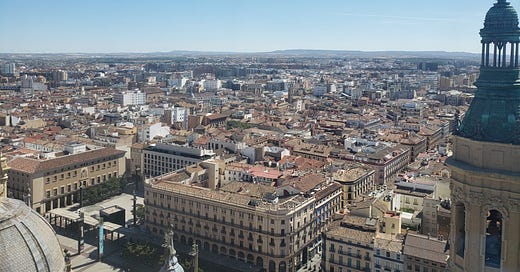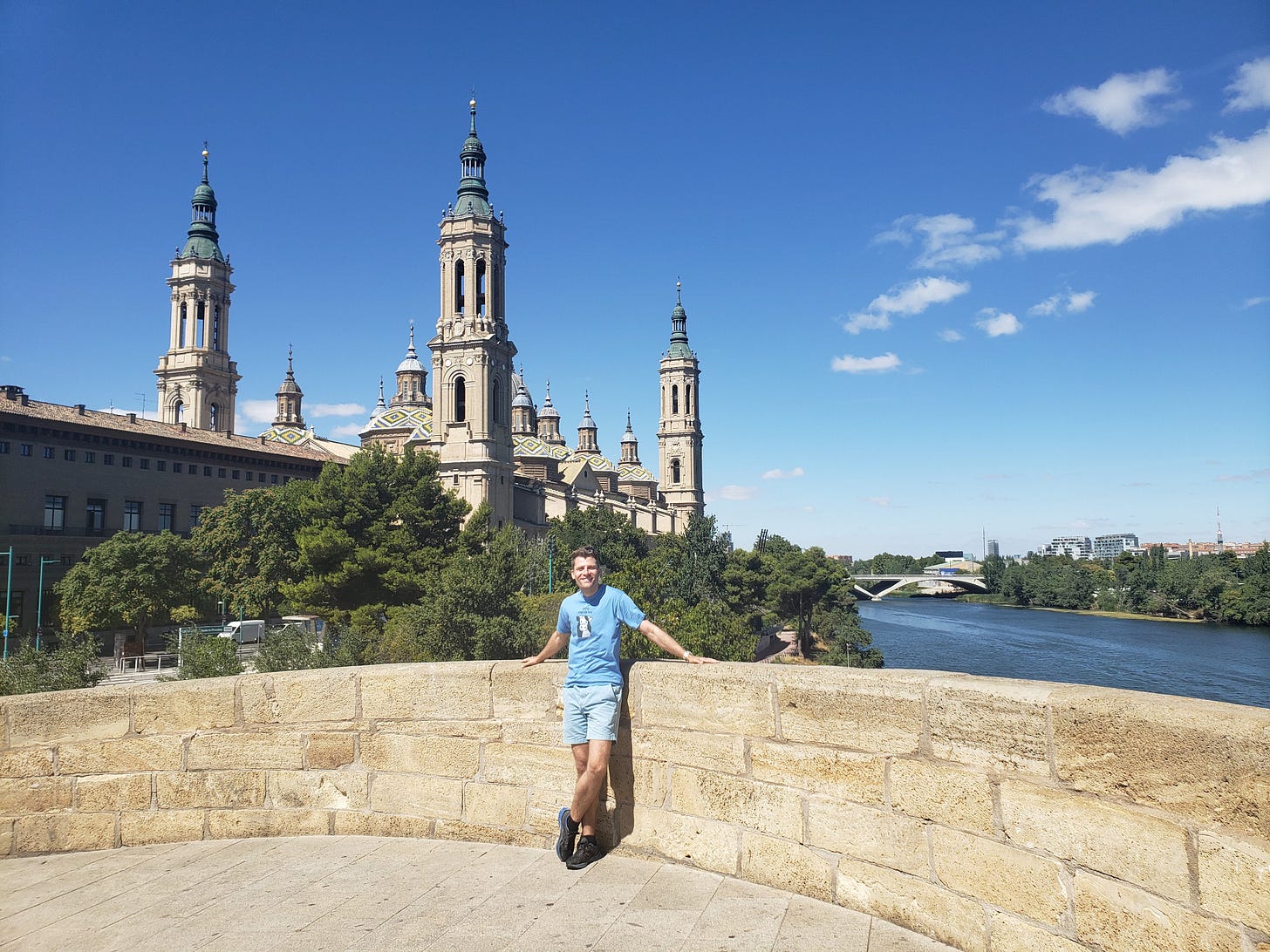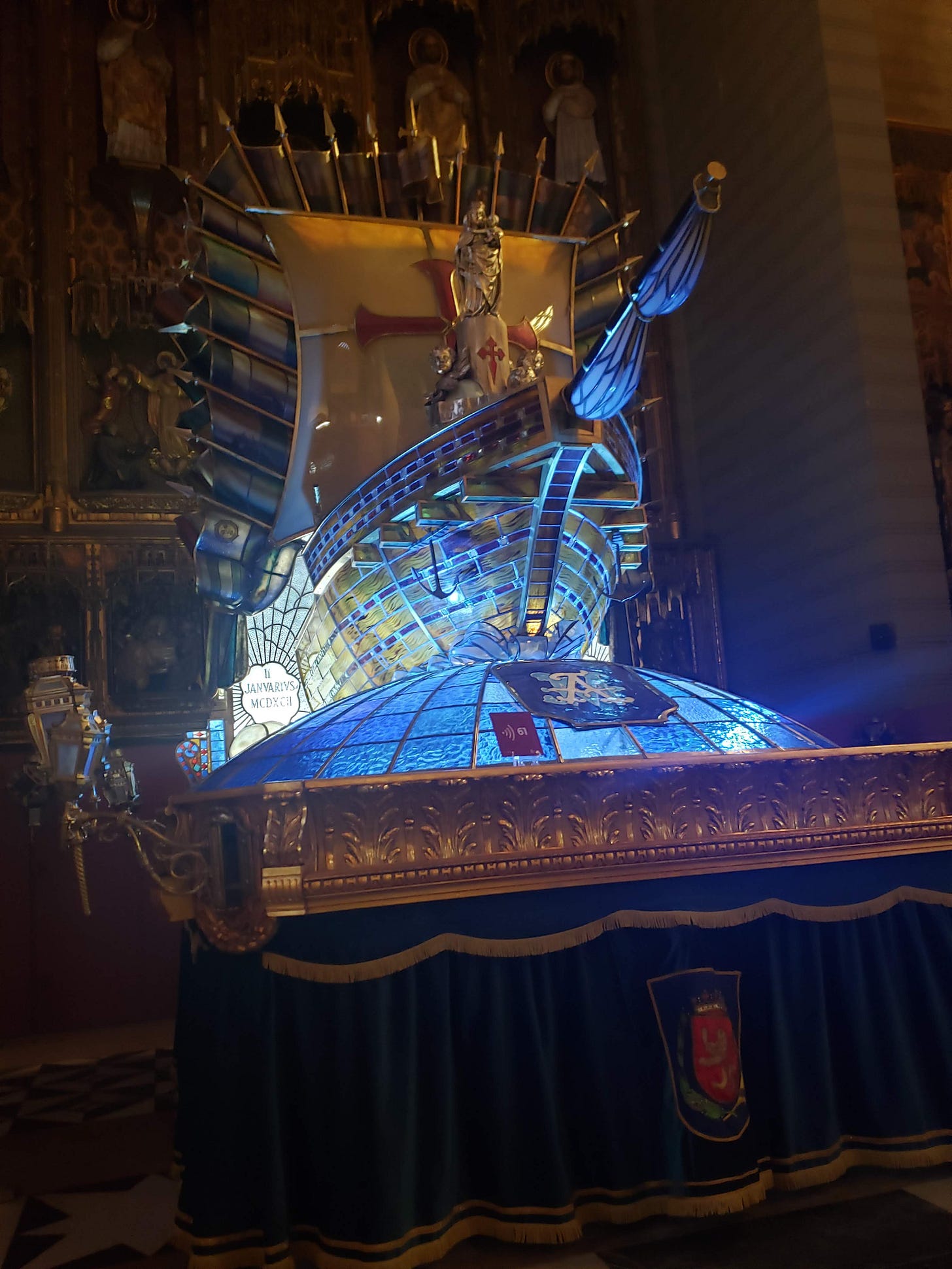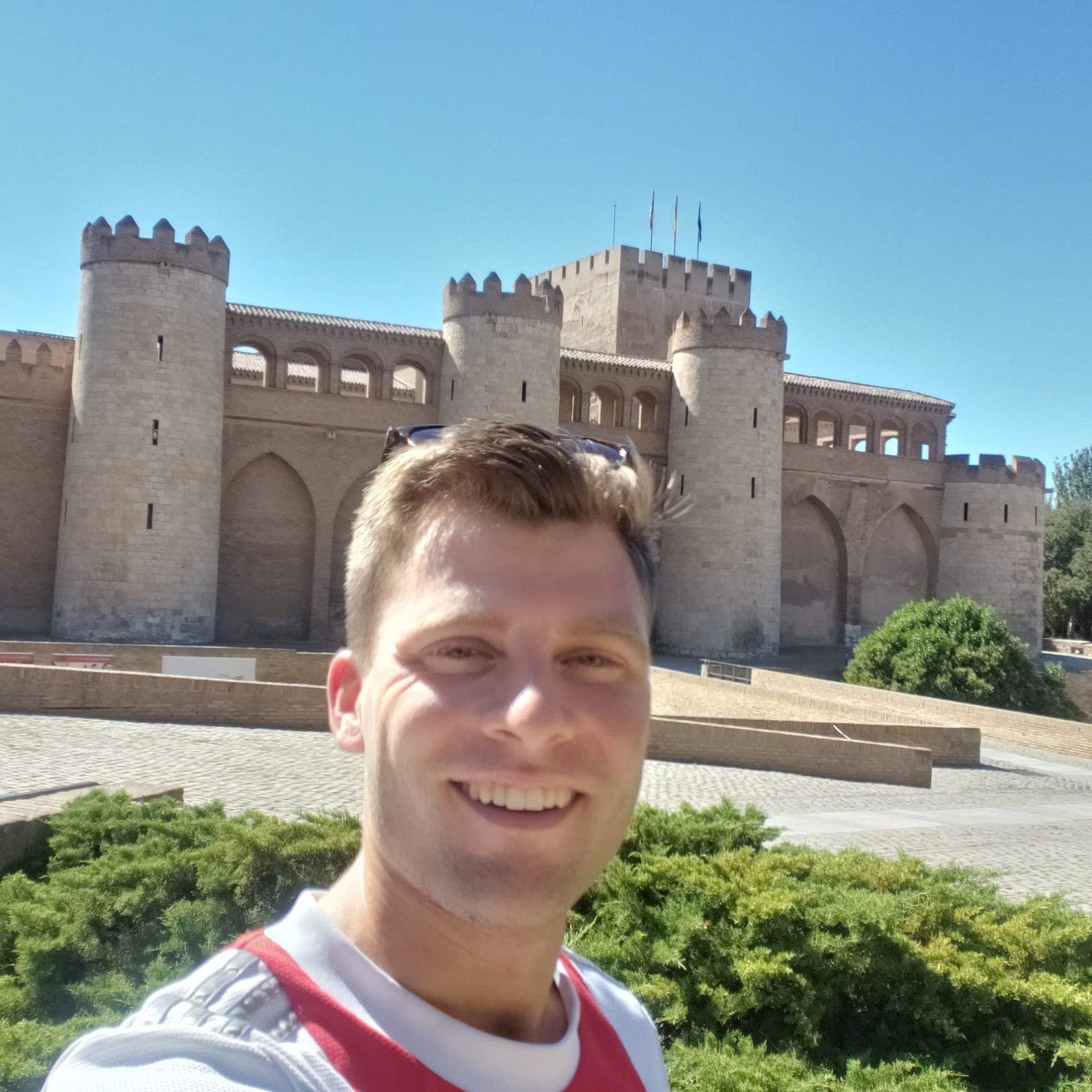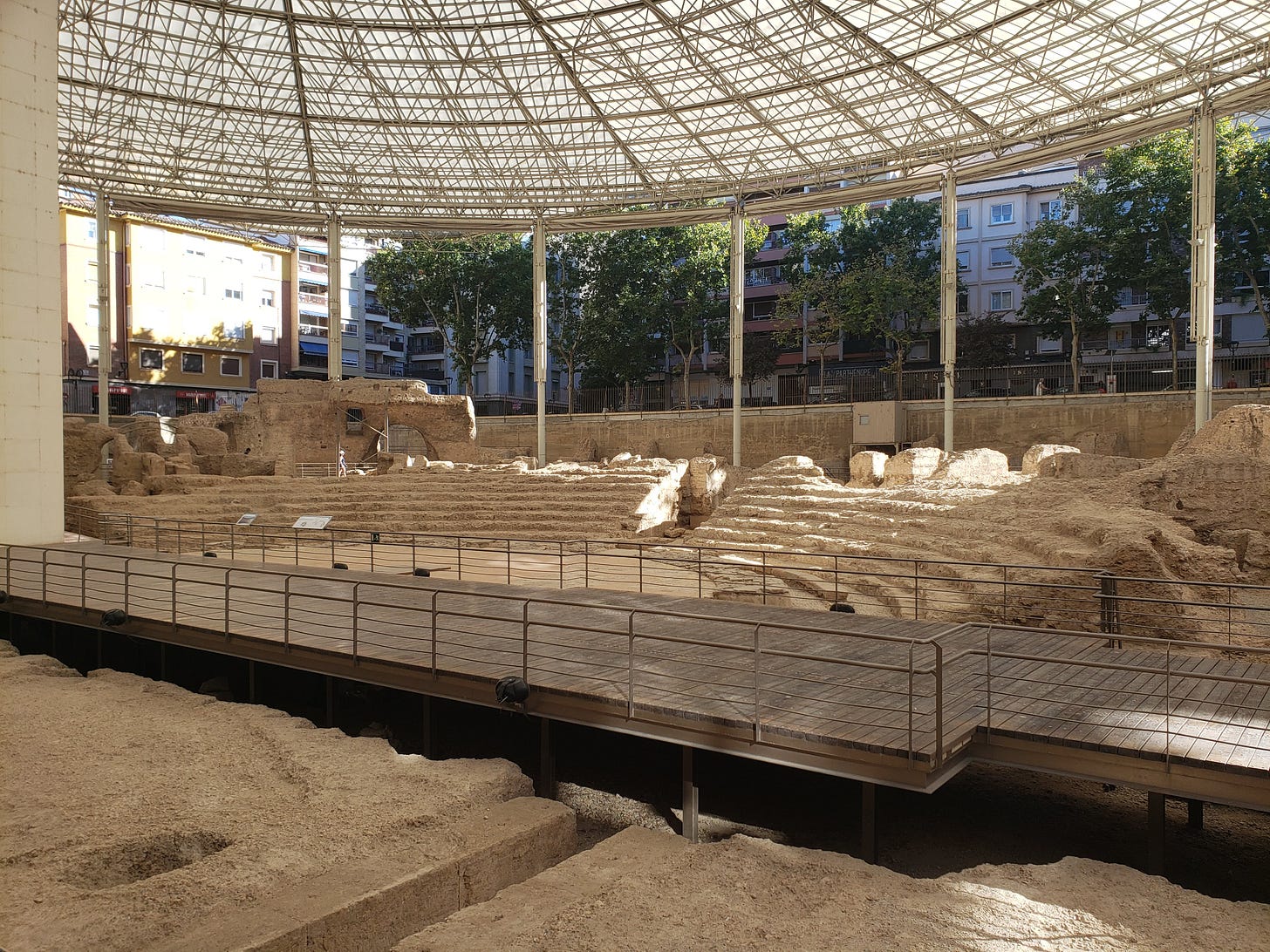I spent five nights and four days in Zaragoza the capital of Aragon. It is a unique city and quite different from the two Spanish cities I’ve visited so far. It is a medium sized city by American standards with five hundred thousand inhabitants. It is the fifth largest city and the eighth largest metropolitan area in Spain. Interestingly, half of the population of the Autonomous Community of Aragon live in Zaragoza. An autonomous community is analogous to a US state. They have a separate legislature and control their own healthcare, education, and various other aspects of government. From the first stepping out of the train it feels much different than either Madrid or Barcelona. From the first impression is calmer and everyone seems just a bit less in a hurry. The city is bisected by Ebro River and the city straddles the river with a half dozen bridges allowing locals to traverse the river. The river is the second longest in Spain and has the second greatest discharge volume in Spain. It is the Ebro River that has brought Zaragoza its prosperity. The climate of Zaragoza is cold semi-arid which means the summers are hot winters are cool and it is always dry. A similar climate in America to compare Zaragoza to is Northern New Mexico and Eastern Colorado. Aragon however is one of the major fruit and wheat growing regions of Spain due to intensive irrigation.
(A view of the city from the northeast tower of el Pilar)
(A view of the city’s bullfighting arena)
Zaragoza is quite an old city. Its first name was Colonia CaesarAugusta and was founded as a Roman colony on the site of a previous Celt-Iberian settlement. The city was founded in 14 BCE and housed veterans of Augustus’ wars against the Cantabrians. In the Medieval period, Zaragoza was the capital of the Kingdom of Aragon. As such wealth, flowed into the city and it remains beautiful. The heart of the city is el Casco Antigou (which translates either to “old town” or “old helmet” depending on how you ask google). The dominating features of el Casco Antigou are the two mammoth cathedrals located on the main plaza. The larger is the two is the el Catedral-basílica de Nuestra Señora del Pilar de Zaragoza (Cathedral Basilica of Our Lady of the Pilar) that lies between the river and the Plaza del Pilar. Downstream of El Pilar is la Catedral del Salvador de Zaragoza (Cathedral of the Savior of Zaragoza). The city emanates from the central locus of the plaza de pilar and ends prior to meeting the highlands which bracket the Ebro and create the Ebro River valley. In this way the Ebro river valley is quite similar to the great rift valley of Kenya a verdant lowland between to rises of mountains and plateaus.
(The Ebro with el Pilar)
The old city of Zaragoza displays the cities past wealth and is quite picturesque with an architectural style quite different from Barcelona or Madrid. The Kingdom of Aragon was a wealthy maritime power controlling most of the trade of the Western Mediterranean Sea. At its zenith, the Aragonese Kings controlled most of Eastern Spain including Barcelona and Valencia, the Balearics, Naples, Sardinia, and Sicily. So, you can imagine why the kings and nobles had some extra spending money to beautify the city. I was most impressed by the old city with its two commanding Cathedrals. They surge into the sky and tower over the neighboring buildings. The building which most awed me was El Pilar. It is a baroque style cathedral-basilica with striking green and yellow glazed tiled roofs. It just takes your breath away. I was quite habituated to the common red terracotta of Spain. So to see the explosion of color is quite something. On the inside, the cathedral is quite beautiful and boasts a frieze by de Goya on the roof of one of the chapels. The cathedral was starting in 1681 and not completed until… 1961! It makes Notre Dame’s 100 years of construction seem like a rushed job! One of the hidden attractions of the Cathedral is the scenic overlook from the northeast tower. For the low low price of 4 euros, you can take an elevator up to the top and see the entire city!
(The stunning tile roofs of el Pilar)
(Me in front of el Pilar on the old stone bridge)
The second great Cathedral of Zaragoza is the Cathedral of the Savior or locally known as Seo (it means to see in the Aragonese language. A separate but dying language more similar to Catalan than Spanish). It is quite different from el Pillar as it is a hybrid of three styles and is the older of the two churches. The church was consecrated in 1318 but as to its construction I really could not tell you. After reading three Spanish brochures I find myself more confused than when I began! The church is a merger of an original Romanesque cathedral, a gothic addition with a final Mudejar dome added. Mudejar is the architectural style created by the fusion of Christian and Arabic art. It is quite a unique structure. The final major Christian attraction in the city is the Museuo de los Faroles y Rosario de Cristal (The Museum of the Rosary and Crystal Lanterns). The museum is housed in a church which currently is the home of dozens of beautiful and intricately designed illuminated glass sculptures. The sculptures are mounted on wagons and on October 12 they process through the town. There is a secondary procession the following day called the Rosary of the Crystal. Wow do the Spaniards love processing and festivals! The two most impressive sculptures were of the Basilica and Christopher Columbus’ Santa Maria.
(A view of Seo with its Mudejar style central tower)
(Two crystal floats of el Pilar y la Santa Maria)
Outside of the old city is the Aljaferia Palace. The palace was the residence of the Emir of Zaragoza, residence of the Kings of Aragon, and is the current home of the Cortes de Aragon (the Aragonese Parliament). The approach to the palace is quite interesting as it is not the original palace instead a restored version. It includes a moat with European seeming ramparts and towers. This Spanish exterior belies the contents of the palace. Upon entering the palace, one realizes that the many occupants of the palace each left their mark upon it. The ground floor retains the original Muslims architectural style with the ornate geometric designs. Rather try to describe the intricate patterns I’ll let this picture tell a thousand words.
(Me in front of Aljaferia)
After the Taifa of Saraqusta (Kingdom of Zaragoza in Arabic) fell, the Aragonese kings did some serious remodeling of the palace which can best be seen on the second floor. The first Aragonese king to change the palace was Peter the fourth who added a Christian chapel and changed the ceilings and bed chambers to match the prevailing European tastes. It is a prime example of the hybridization of Spanish and Arab art and is fascinating to see the changes in the palace over the centuries. After the tour of the palace, one finds oneself in the center of the current parliament hall. It is fascinating that the government of Aragon, choses to hold their debates and legislate in a medieval castle!
(The cool courtyard of the Palace)
After exploring the old town, I was drawn to the Roman sights of Zaragoza. (writer’s note, after attempting to write this section I realized there is simply too much to cover. I’ll add a supplement on the sights of roman CaesarAugusta later this week). In Zaragoza, there are four primary Roman ruins. In order of significance, they are the theater, the forum, the dockyards, and the baths. The archeological history of Zaragoza is quite interesting as it is very recent, all these sites were buried until quite recently. The theater was only unearthed in 1973! The theater was 45 feet tall and could seat 6,000. This is in a city which was estimated to have 20,000 inhabitants. Unfortunately, all that remains are the foundations of the theater as the rest was used to create city walls to protect against the raiding Goths and Vandals during the collapse of the empire. One other fun fact was that the Romans were able to have curtains without an arch over the stage! They used an ingenious system of posts and counterweights to hide the actors during transitions. The ingenuity of the Roman civil and mechanical engineers never ceases to amaze me!
(The Roman Theater of CaesarAugusta)
Like the theater the forum museum was quite large. It is located beneath the plaza del pilar (quite impressive as one cannot tell while walking the plaza that the earth beneath is hollow). Some of the interesting artifacts in the forum museum are the 2 four-meter lead pipes which were recovered intact. The romans were known for their sewage systems, aqueducts, and civil engineering however it is uncommon to find intact the metal pipes as they were typically scavenged. The bath and port museums were interesting as well, and I’ll go into further depth in the supplementary article on the classical history of the city.
The final museums I had the good fortune to visit were the de Goya Museum and the Zaragoza Museum, both art museums. The primary recommendation for the Zaragoza Museum is that it is free! I will always leap at an opportunity for a free art museum! It has a quite a few interesting pieces and is most noteworthy for its works by de Goya. After a taste of Aragonese art at the Zaragoza Museum, I decided to satiate my hunger at the de Goya Museum. It is quite impressive collection of the famous Spanish painter. Many of his works found their way to Zaragoza as he is a native son of the land. He was a disciple of Velazquez and produced incredible technical works. What I found especially interesting were his satirical woodcuts which mocked the reactionary elements of the contemporary Spanish state and church. He used the medium of art to criticize the ruling conservative power structure which ultimately led to his exile to France. He is quite the interesting artist. A fun fact about the museum is that during the renovation of the original historic building they found in the basement more roman ruins of a domus (home). It seems if you dig a hole for a tree in Zaragoza you find a historically significant ruin! What an amazing city.
After five days spent in Zaragoza, I feel like I just scratched the surface of the city and the Autonomous community of Aragon. There was just so much to see so much to do, and the people were so kind. I think the things I will best remember is the incredibly cheap and high-quality fruit! I could get a kilo of fresh peaches for 1.5 euros. What a deal! Another interesting find in the city was the bronze statue of Caesar Augustus modeled after the Augustus Prima Porta in the Vatican. This statue was a gift from Mussolini in 1940! The truth is sometimes stranger than fiction. What a wonderful city and I hope to explore more of it soon!
